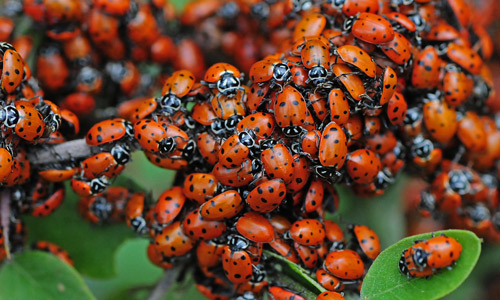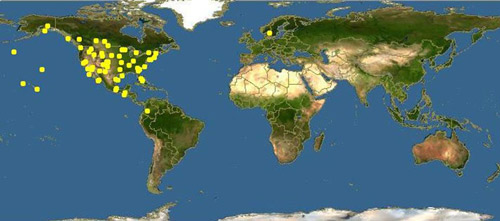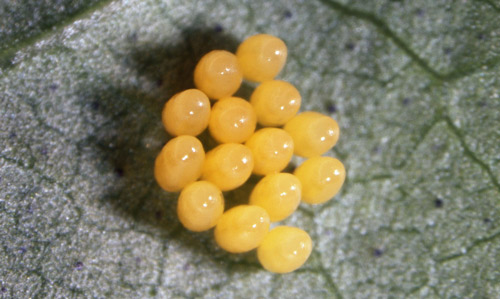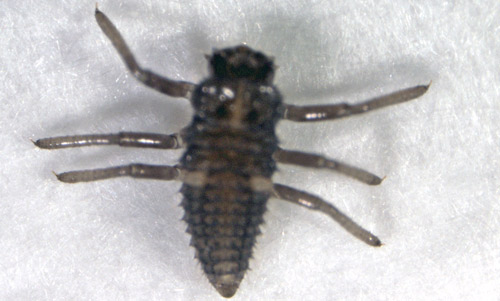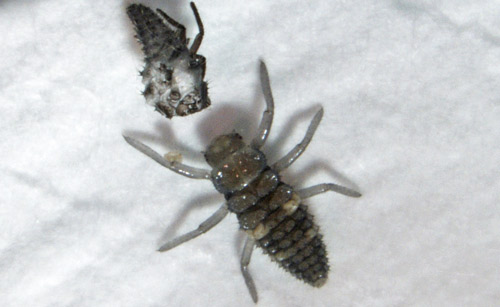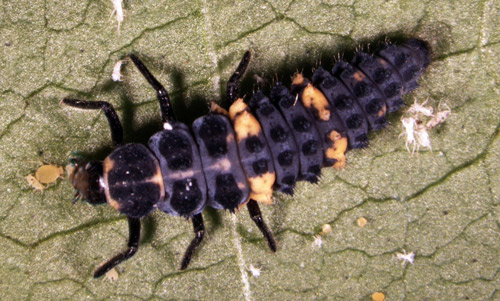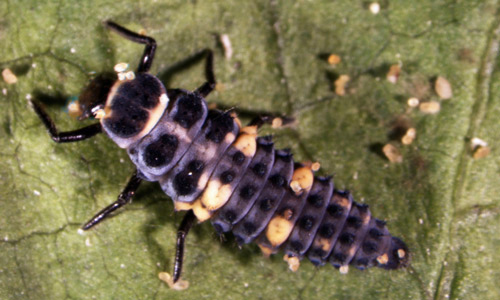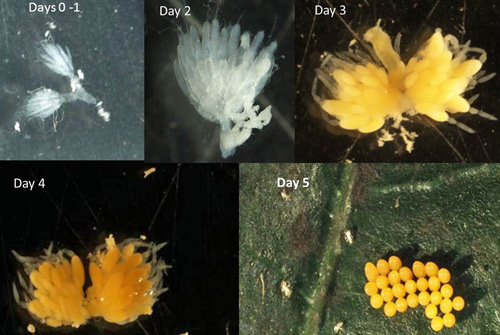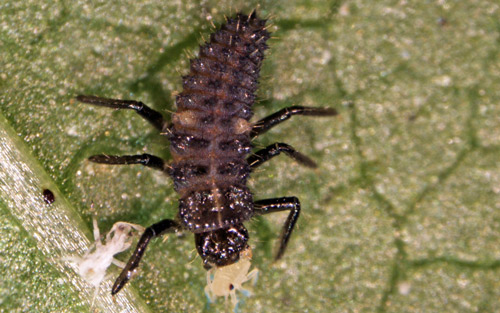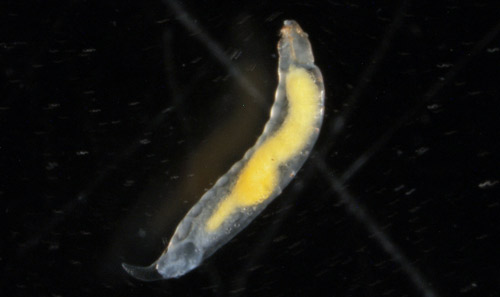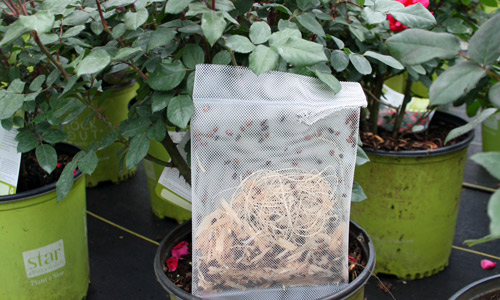common name: convergent lady beetle
scientific name: Hippodamia convergens Guérin-Méneville (Insecta: Coleoptera: Coccinellidae)
Introduction - Distribution - Description - Seasonal Biology - Predatory Behavior - Natural Enemies - Use as Biological Control Agent - Selected References
Introduction (Back to Top)
The convergent lady beetle, Hippodamia convergens Guérin-Méneville, is among the most common lady beetle species throughout North America and is an important natural enemy of aphids, scales, thrips, and other soft-bodied insects. It will also feed on pollen and nectar from flowers when prey is scarce. This species can be found in habitats ranging from grasslands, forests, agricultural fields, gardens, and natural parks. It is one of the few natural enemies that are currently wild-collected from mass aggregations for distribution to the pest control industry (Figure 1).
Figure 1. Mass of convergent lady beetles in Alamo Peak, Otero Co., NM. Photograph by Jerry Oldenettel.
Distribution (Back to Top)
Convergent lady beetles are widespread throughout North America (the United States, western Canada and Mexico) and Central America, but only recorded from Colombia in South America (Figure 2). In the United States, the convergent lady beetle can be found from California to New Jersey and Hawaii, with smaller populations in the eastern states. In some areas, the convergent lady beetle, along with other native species, may be displaced by the invasive Asian multicolored ladybeetle, Harmonia axyridis (Pallas).
Figure 2. Reported geography distribution of the Hippodamia convergens. Image from Global Biodiversity Information Facility database.
Description (Back to Top)
The adult is rounded and elongate-oval, averaging 7.8 mm (0.3 inch) long for females and 5.8 mm (0.23 inch) long for males. Adults are easily recognized by their bright red or orange elytra (hardened forewings) which usually have 12 black spots (6 on each elytron). The prothorax (area behind the head) is black with a white border and two white, converging lines, which give rise to the insect’s common name. Marking on the elytra are variable, with some individuals less spotted or spotless, but the white lines that converge behind the head are common to all individuals. The legs, head, and underside are black. The legs are short with 3-segmented tarsi, and the antennae are short and clubbed.
Figure 3. Newly emerged adult Hippodamia convergens showing typical body markings. Photograph by Luis F. Aristizábal, University of Florida.
Clusters of yellow eggs are laid by the adult female beetle in batches of 10-30 eggs on stems or leaves of plants where abundant insect prey is present. Individual eggs are spindle-shaped and 1-1.5 mm (≈1/20th inch) long and laid pointing upwards.
Figure 4. Eggs of Hippodamia convergens (1 day old). Photograph by Luis F. Aristizábal, University of Florida.
The larvae are black with orange spots on the prothorax and abdomen and look like small alligators. Larvae develop through four instars (stages) growing progressively larger and more spotted with orange and reaching about 7 mm (1/4 inch) before becoming a pupa. The pupa is hemispherical and orange and black.
Figure 5. First instar larvae of Hippodamia convergens. Photograph by Luis F. Aristizábal, University of Florida.
Figure 6. Second instar larvae of Hippodamia convergens. Photograph by Luis F. Aristizábal, University of Florida.
Figure 7. Third instar larvae of Hippodamia convergens. Photograph by Luis F. Aristizábal, University of Florida.
Figure 8. Fourth instar larvae of Hippodamia convergens. Photograph by Luis F. Aristizábal, University of Florida.
Figure 9. Pupa of Hippodamia convergens. Photograph by Luis F. Aristizábal, University of Florida.
Seasonal Biology (Back to Top)
Convergent lady beetle is a bivoltine species, with two generations per year (spring and fall) over much of its range. There may be additional generations in the south; the life cycle in Florida has not been reported. During the summer and winter when temperatures are too high or low, and during periods when food sources are insufficient for reproduction, adult convergent lady beetles enter into reproductive diapause. During these periods, adults may aggregate under tree branches or under rocks.
The abundance of food plays an important role in their fecundity. Before laying eggs (ovipositing), the female needs to consume an adequate source of carbohydrates and proteins. If food is plentiful, the pre-oviposition is about 5 days after mating (Figure 10); if food is in short supply, the female may wait several days or weeks before starting to oviposit. The adults can eat honeydew, nectar, and pollen when prey is scarce, however females must consume aphids or other live prey to reproduce. Each well-fed female may lay 200 or more eggs during her life. The developmental period (egg to adult) for convergent lady beetles measured in our laboratory under conditions of 25° C, 80% relative humidity and 16 hours daylight is about 21 days (averaging 3.5 days for egg stage, 2.6 days for first instar, 2.7 days for second instar, 2.1 days for third instar, 3.8 days fourth instar and 5.4 days for the pupa).
Figure 10. Ovariole development of Hippodamia convergens fed aphids at 25° C. Photograph by Steven Arthurs, University of Florida.
Predatory Behavior (Back to Top)
Convergent lady beetle larvae are active predators and begin searching for small insects soon after they hatch from the egg. In some cases, the unhatched eggs are eaten by the first larvae to emerge. Visual, olfactory, and chemical cues, including pheromones and honeydew secreted by aphids, may be used to locate prey. Larger larvae are voracious feeders and may consume between 30 and 50 aphids per day. When food is scarce, Hippodamia convergens can become cannibalistic.
This lady beetle is an important natural biological control agent for aphid pests found on cotton, potato, corn, peach, melon, cabbage, and other crops. Reported prey include the Russian wheat aphid, Diuraphis noxia (Nordvilko), the corn leaf aphid, Rhopalosiphum maidis (Fitch), the bird cherry oat aphid, Rhopalosiphum padi (L.), the tobacco aphid, Myzus nicotianae (Blackman), and the pea aphid, Acyrthosiphon pisum (Harris). Eggs and larvae of other small insects, such as potato psyllids, Bactericera cockerelli (Sulc), and asparagus beetles, Crioceris asparagi (L.), are reported as prey items.
Recently some citrus producers in Florida have released large numbers of commercially obtained convergent lady beetles from California against the Asian citrus psyllid Diaphorina citri (Kuwayama), vector of the causal agent of the devastating Huanglongbing or citrus greening disease and the citrus aphid, Aphis spiraecola (Patch). However, there is currently little information on efficacy of this predator against the psyllid or other pests in citrus groves in Florida.
Figure 11. Hippodamia convergens second instar larvae feeding on melon aphid. Photograph by Luis F. Aristizábal, University of Florida.
Natural Enemies (Back to Top)
Generalist predators such as large big-eyed bugs, Geocoris bullatus (Say), and damsel bugs, Nabis alternatus (Parshley), are reported as natural enemies of convergent lady beetle eggs. The braconid wasp Dinocampus (=Perilitus) coccinellae (Schrank) has been found parasitizing convergent lady beetles (Figure 11). Some microsporidian diseases (primitive fungi) have also been recovered from field-collected specimens. The microsporidian Nosema hippodamiae is thought to cause chronic and sublethal effects, such as reduced fecundity and survival of adults. Many birds are predators of ladybeetles as well. However the red color with black spots on the elytra may play a role as warning coloration, and ladybeetles with spots, such as Hippodamia convergens, tend to be eaten less frequently than unspotted ones.
Figure 12. Larva of a parasitic wasp (probably Dinocampus coccinellae) recovered from Hippodamia convergens. Photograph by Steven Arthurs, University of Florida.
Use as a Biological Control Agent (Back to Top)
Although convergent lady beetles are generally a solitary species, they exhibit periodic aggregation behaviors. This phenomenon is displayed when large numbers of adults from the fall generation migrate to cooler mountain regions to overwinter. During the following spring season, these adults migrate back to agricultural fields, grasslands and other rural areas in search of aphids and places to lay their eggs. This aggregation behavior is typical of Hippodamia convergens but not generally observed in other lady beetle species except for Harmonia axyridis, which aggregates in structures.
The most famous large aggregations of this species occur in the Sierra Nevada Mountains of California. Each year, large quantities of beetles are collected from these overwintering sites and put into refrigerated storage before being packaged and distributed to growers and garden outlets. Most companies package and distribute convergent ladybeetles in quantities ranging from 1,500 to 72,000 adults for use against aphids, mites, whiteflies, thrips, and mealybugs, with recommended release rates around 1,500 adults per 500 square feet or 70,000 adults per acre.
The tradition of using this species as a form of natural pest control has continued, despite reports that field-collected beetles may harbor parasites and pathogens that may be inadvertently released along with the beetles. Moreover, since most wild-collected beetles overwinter while reproductively immature (ovaries are not yet developed) and have a natural tendency to disperse away from release sites, their effectiveness as biological control agents for gardeners and organic crops production is not guaranteed. The Association of Natural Biocontrol Producers does not endorse the collection of biocontrol organisms from their natural habitat destined for resale.
Figures 13. Release of Hippodamia convergens on rose plants. Photograph by Luis F. Aristizábal, University of Florida.
Selected References (Back to Top)
- Bjørnson S. 2008. Natural enemies of the convergent lady beetle, Hippodamia convergens Guérin-Méneville: Their inadvertent importation and potential significance for augmentative biological control. Biological Control 44: 305-311.
- Darby A, Raymond B, Douglas A. 2003. The olfactory response of coccinellids to aphids on plants. Entomologia Experimentalis et Applicata 95: 113-117.
- Dolenska M, Nedved O, Vesely P, Tesarova M, Fuchs R. 2009. What constitutes optical warning signals of ladybirds (Coleoptera: Coccinellidae) towards bird predators: colour, pattern or general look? Biological Journal of the Linnaen Society 98: 234-242.
- Eigenbrode SD, White C, Rohde M, Simon CJ. 1998. Behavior and effectiveness of adult Hippodamia convergens (Coleoptera: Coccinellidae) as a predator of Acyrthosiphon pisum (Homoptera: Aphididae) on a wax mutant of Pisum sativum. Environmental Entomology 27: 902-909.
- Jamal E, Brown G. 2001. Orientation of Hippodamia convergens (Coleoptera: Coccinellidae) larvae to volatile chemicals associated with Myzus nicotianae (Homoptera: Aphididae). Environmental Entomology 30: 1012-1016.
- Joudrey P, Bjørnson S. 2007. Effects of an unidentified microsporidium on the convergent lady beetle, Hippodamia convergens Guérin-Méneville (Coleoptera: Coccinellidae), used for biological control. Journal of Invertebrate Pathology 94: 140-3.
- Katsarou I, Margaritopoulos J, Tsitsipis J, Perdikis D, Zarpas K. 2005. Effect of temperature on development, growth and feeding of Coccinella septempunctata and Hippodamia convergens reared on the tobacco aphid, Myzus persicae nicotianae. Biocontrol 50: 565-588.
- Michaud J, Qureshi J. 2006. Reproductive diapause in Hippodamia convergens (Coleoptera: Coccinellidae) and its life history consequences. Biological Control 39: 193-200.
- Purandare S, Tenhumberg B. 2012. Influence of aphid honeydew on the foraging behaviour of Hippodamia convergens larvae. Ecological Entomology 37: 184-192.
- Qureshi JA, Stansly PA. 2011. Three homopteran pests of citrus as prey for the convergent lady beetle: suitability and preference. Environmental Entomology 40: 1503-10.
- Rodriguez SC, Miller JC. 1995. Life history traits in Hippodamia convergens (Coleoptera: Coccinellidae) after selection for fast development. Biological Control 5: 389-396.
- Saito T, Bjørnson S. 2006. Horizontal transmission of a microsporidium from the convergent lady beetle, Hippodamia convergens Guérin-Méneville (Coleoptera: Coccinellidae), to three coccinellid species of Nova Scotia. Biological Control 39: 427-433.
- Saito T, Bjørnson S. 2013. The convergent lady beetle, Hippodamia convergens Guérin-Méneville and its endoparasitoid Dinocampus coccinellae (Schrank): the effect of a microsporidium on parasitoid development and host preference. Journal of Invertebrate Pathology 113: 18-25.
- Seagraves MP. 2009. Lady beetle oviposition behavior in response to the trophic environment. Biological Control 51: 313-322.
- Sluss R. 1968. Behavioral and anatomical responses of the convergent lady beetle to parasitism by Perilitus coccinellae (Schrank) (Hymenoptera: Braconidae). Journal of Invertebrate Pathology 10: 9-27.
- Takizawa T, Snyder W. 2012. Alien vs. predator: Could biotic resistance by native generalist predators slow lady beetle invasions? Biological Control 63: 79-86.
- Wells ML, McPherson RM. 1999. Population dynamics of three coccinellids in flue-cured tobacco and functional response of Hippodamia convergens (Coleoptera: Coccinellidae) feeding on tobacco aphids (Homoptera: Aphididae). Environmental Entomology 28: 768-773.
